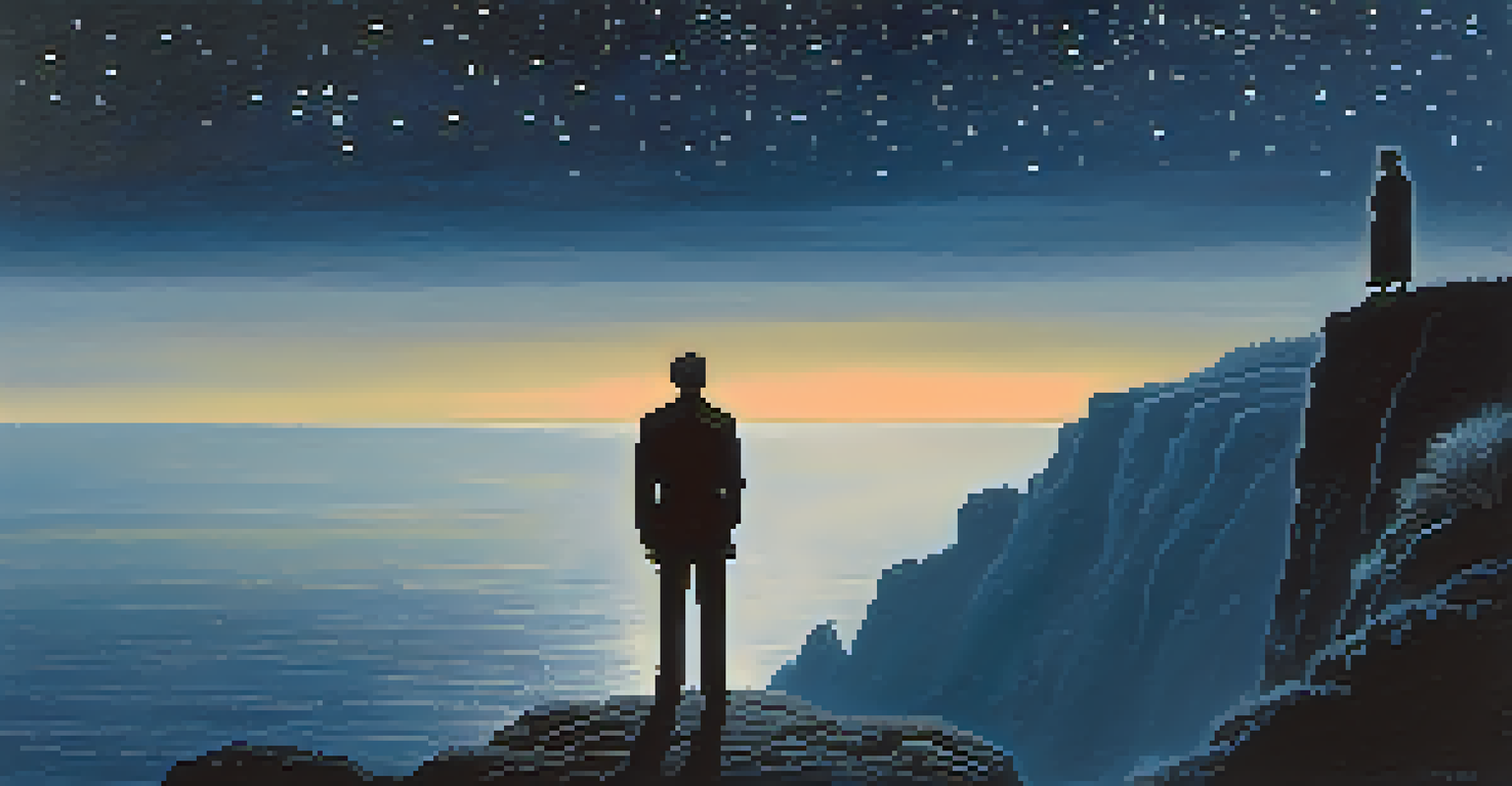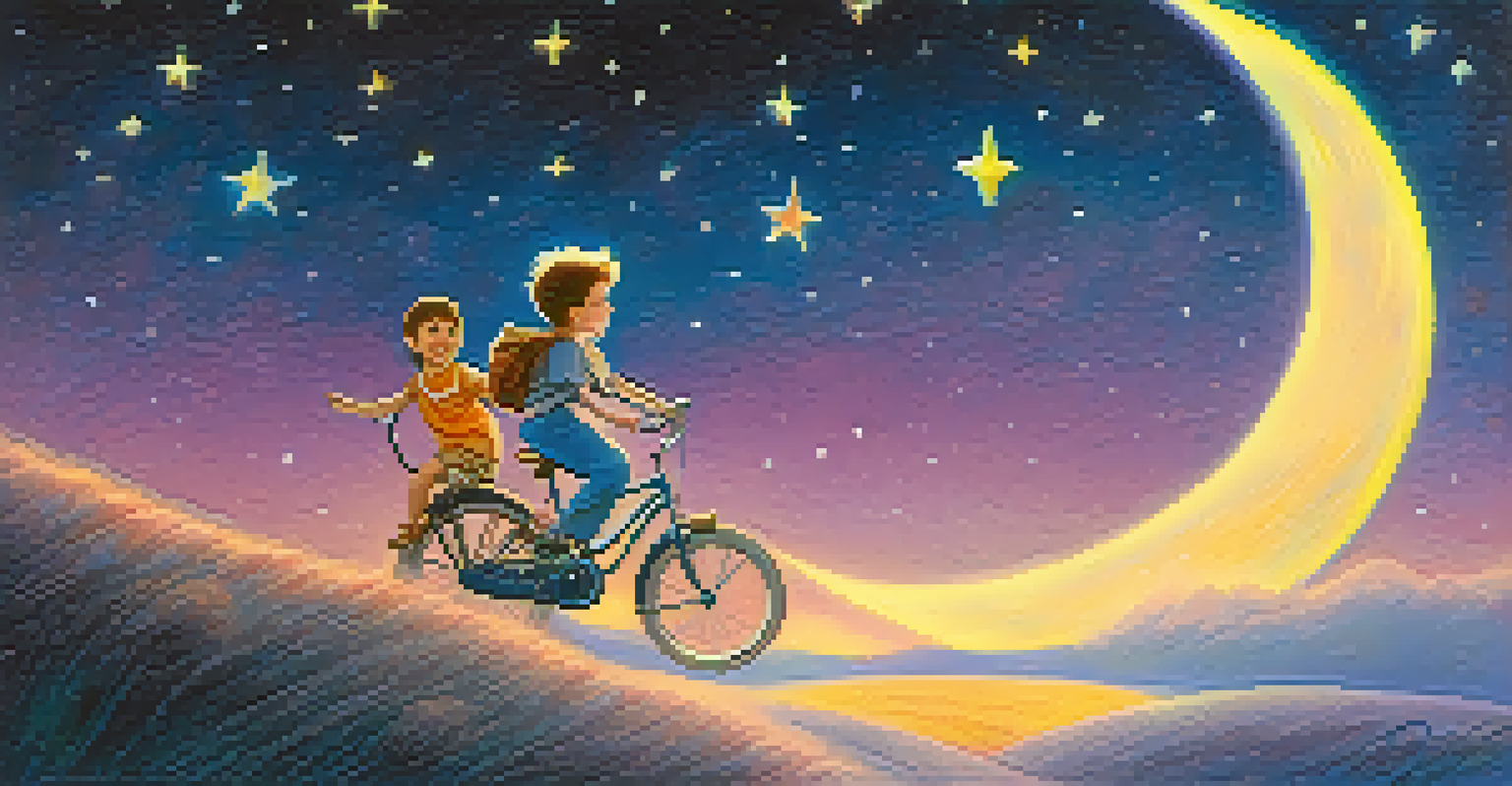Iconic Film Posters: What Makes Them Stand Out?

The Power of Visual Storytelling in Film Posters
Film posters are much more than just promotional tools; they are visual narratives that convey the essence of a movie. They capture the tone, genre, and emotion, often using striking imagery to draw the viewer in. For example, the poster for 'Jaws' uses the ominous image of the shark lurking beneath the surface to evoke fear before the audience even steps into the theater.
A picture is worth a thousand words.
This visual storytelling is crucial because it sets expectations for the audience. A well-designed poster can communicate whether a film is a thriller, a comedy, or a romantic drama, helping viewers decide whether it aligns with their interests. Just as a book cover can entice a reader, a film poster can spark curiosity and anticipation.
Moreover, iconic film posters often become cultural symbols, transcending their original purpose. They can evoke nostalgia or even influence fashion and art, as seen with the 'Breakfast at Tiffany's' poster featuring Audrey Hepburn. This blend of storytelling, emotional resonance, and cultural significance is what makes certain film posters unforgettable.
Color Schemes: The Emotional Palette of Film Posters
Color is a fundamental element in design that can evoke specific emotions and set the mood for a film. Iconic posters often use color schemes strategically to reflect the film's theme or tone. For instance, the vibrant reds and yellows in the 'The Lion King' poster create a sense of warmth and adventure, enticing families and children to the cinema.

In contrast, darker shades and muted tones can convey a more serious or intense atmosphere. Take the 'The Sixth Sense' poster, which utilizes a palette of deep blues and blacks to hint at the film's suspenseful and eerie themes. These color choices are not random; they are meticulously crafted to elicit emotional responses from potential viewers.
Visuals Convey Film's Essence
Film posters serve as visual narratives that communicate a movie's tone, genre, and emotional impact.
Additionally, color can play a role in brand identity for franchises. The iconic green of the 'Ghostbusters' logo has become synonymous with the franchise, making it easily recognizable. This connection between color and emotion is what helps certain film posters stand out in a crowded marketplace.
Typography: Crafting the Voice of a Film Through Fonts
Typography is another critical aspect that contributes to a film poster's impact. The choice of fonts can communicate a film's genre and tone at a glance. For example, the bold, angular letters of the 'Mad Max: Fury Road' poster convey a sense of action and urgency, perfectly aligning with the film's high-octane vibe.
Design is the silent ambassador of your brand.
Conversely, elegant script fonts may be employed for romantic films, like 'Pride and Prejudice,' to evoke a sense of grace and sophistication. The typography not only serves to inform viewers of the film's title but also reinforces the overall aesthetic and emotional tone.
Moreover, iconic font styles can become integral to a film's identity. The distinctive logo of 'Star Wars' is instantly recognizable, and this typeface has become part of popular culture. The power of typography goes beyond mere text; it shapes the narrative before anyone even reads the storyline.
Imagery: The Visual Hooks that Captivate Audiences
Imagery is at the heart of a film poster's effectiveness. The visuals chosen for a poster can instantly captivate potential viewers, creating intrigue and excitement. For instance, the poster for 'E.T. the Extra-Terrestrial' features the iconic image of E.T. and Elliott flying over the moon, which has become emblematic of the film’s magical themes.
Effective imagery often includes elements that represent key themes or characters, enticing viewers to learn more. A well-placed visual hook can spark curiosity and lead to discussions, making it more likely that people will seek out the film. The striking image of the red balloon in 'It' is a perfect example of how a single visual can provoke thought and interest.
Color Sets Emotional Tone
Strategic color schemes in film posters evoke specific emotions and reflect the film's themes.
Additionally, the composition of these images plays a crucial role. The arrangement of characters, objects, and background can guide the viewer's eye and create a narrative within the poster itself. This thoughtful design is what elevates certain film posters to iconic status.
Iconic Taglines: Crafting Memorable Messages
A compelling tagline can elevate a film poster by providing a memorable phrase that encapsulates the film's essence. These short, catchy lines often stick in the audience's mind long after they've seen the poster. For example, the tagline for 'The Godfather' – 'An offer you can't refuse' – immediately conveys a sense of intrigue and power.
Taglines serve as a form of storytelling in themselves, offering a glimpse into the film's themes or conflicts. They can also evoke emotions, prompting viewers to feel curious, excited, or even scared. The tagline for 'Jaws,' 'You'll never go in the water again,' cleverly plays on fear, perfectly complementing the poster's visual elements.
Moreover, a well-crafted tagline can enhance a film's marketing strategy, making it more shareable and memorable. Iconic taglines often become part of pop culture, contributing to the film's legacy. This ability to encapsulate a film's message in just a few words is what makes taglines an essential element of iconic film posters.
Cultural Context: Reflecting Society Through Film Posters
Film posters often reflect the cultural context in which they were created, serving as a mirror to society's values and norms. For instance, posters from the 1950s often showcased idealized family structures and gender roles, mirroring the societal expectations of the time. This connection between film and culture can make certain posters particularly resonant.
Moreover, iconic film posters can challenge or subvert these norms, prompting discussions about societal issues. The poster for 'Black Panther' depicted a strong, regal Black hero in a time when representation was both crucial and often lacking in mainstream cinema. This cultural significance adds layers to the poster’s importance, making it memorable beyond its visual appeal.
Taglines Enhance Memorability
Compelling taglines provide memorable phrases that encapsulate a film's essence and resonate with audiences.
Additionally, the evolution of film posters over time reflects broader changes in the industry and society. From hand-painted illustrations to modern digital designs, each era’s posters tell a story of artistic and cultural progression. This interplay between film and culture is what makes certain posters stand out and remain relevant.
Nostalgia: How Iconic Posters Evoke Fond Memories
Nostalgia plays a significant role in the enduring appeal of iconic film posters. Many of us have fond memories associated with specific films, and their posters often evoke those feelings, transporting us back to the first time we saw them. The poster for 'The Wizard of Oz' with its vibrant colors and whimsical imagery is a prime example, reminding viewers of childhood adventures.
This emotional connection can be powerful, as it ties personal memories to cultural moments. For individuals who grew up watching certain films, their posters can serve as cherished reminders of simpler times. This interplay between nostalgia and visual design is what makes certain posters not just iconic, but deeply personal.

Moreover, nostalgia can drive engagement, as fans share and discuss their favorite posters online. The resurgence of retro designs in modern film marketing taps into this sentiment, appealing to both new audiences and those who remember the originals. This shared nostalgia can create a community around films, further solidifying their place in popular culture.